Deck 4: Elasticity
Question
Question
Question
Question
Question
Question
Question
Question
Question
Question
Question
Question
Question
Question
Question
Question
Question
Question
Question
Question
Question
Question
Question
Question
Question
Question
Question
Question
Question
Question
Question
Question
Question
Question
Question

Unlock Deck
Sign up to unlock the cards in this deck!
Unlock Deck
Unlock Deck
1/35
Play
Full screen (f)
Deck 4: Elasticity
1
Which will have a more price-elastic supply over six months: real estate in downtown Manhattan or real estate in rural Oklahoma? Explain your reasoning.
Price elasticity of supply:
Price elasticity of supply refers to the responsiveness of quantity supply of a good due to change in its price.The factors price elasticity of supply:
When there is constrained on input and inflexible production process, then the price elasticity of supply is inelastic and the supply is for a shorter duration than it is inelastic.The price elasticity supply of real estate of 'Ma' and 'Okla':
There is higher constrained in real estate supply in downtown 'Ma' than rural 'Okla'. So, the price elasticity supply in rural 'Okla' more elastic than in downtown 'Ma'.
Price elasticity of supply refers to the responsiveness of quantity supply of a good due to change in its price.The factors price elasticity of supply:
When there is constrained on input and inflexible production process, then the price elasticity of supply is inelastic and the supply is for a shorter duration than it is inelastic.The price elasticity supply of real estate of 'Ma' and 'Okla':
There is higher constrained in real estate supply in downtown 'Ma' than rural 'Okla'. So, the price elasticity supply in rural 'Okla' more elastic than in downtown 'Ma'.
2
In each of the following instances, determine whether supply is elastic, inelastic, or unit-elastic.
a. If price increases by 10 percent and quantity supplied increases by 15 percent, supply is ______.
b. If price decreases by 10 percent and quantity supplied decreases by 5 percent, supply is ______.
a. If price increases by 10 percent and quantity supplied increases by 15 percent, supply is ______.
b. If price decreases by 10 percent and quantity supplied decreases by 5 percent, supply is ______.
a.Given Information:
• The Price increases by 10%3
• Quantity supplied increase by 15%
Elasticity of supply
The elasticity of supply is calculated as: The price elastic of supply is
The price elastic of supply is  . Since it is greater than 1, the price elastic of supply is elastic.b.Given Information:
. Since it is greater than 1, the price elastic of supply is elastic.b.Given Information:
• Price decrease by 10%
• Quantity supplied decrease by 5%
Elasticity of supply
The elasticity of supply is calculated as: The price elastic of supply is
The price elastic of supply is  . Since elasticity of supply is less than 1, the price elastic of supply is inelastic.
. Since elasticity of supply is less than 1, the price elastic of supply is inelastic.
• The Price increases by 10%3
• Quantity supplied increase by 15%
Elasticity of supply
The elasticity of supply is calculated as:
 The price elastic of supply is
The price elastic of supply is  . Since it is greater than 1, the price elastic of supply is elastic.b.Given Information:
. Since it is greater than 1, the price elastic of supply is elastic.b.Given Information: • Price decrease by 10%
• Quantity supplied decrease by 5%
Elasticity of supply
The elasticity of supply is calculated as:
 The price elastic of supply is
The price elastic of supply is  . Since elasticity of supply is less than 1, the price elastic of supply is inelastic.
. Since elasticity of supply is less than 1, the price elastic of supply is inelastic. 3
Problems 7 and 8 refer to the demand schedule shown in Table 4P-1. For each price change, say whether demand is elastic, unit-elastic , or inelastic , and say whether total revenue increases, decreases , or stays the same.
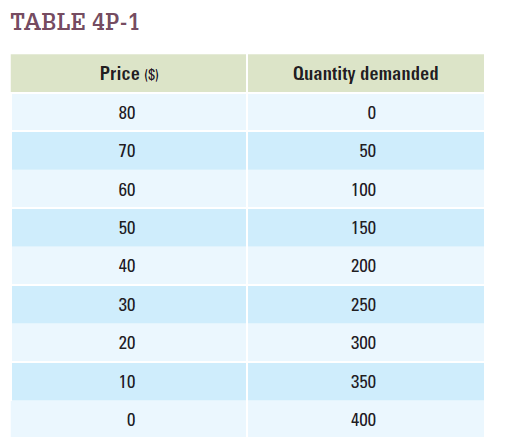
Price decreases from $70 to $60. Demand is ______ and total revenue _______.

Price decreases from $70 to $60. Demand is ______ and total revenue _______.
Given Information:
Table -1 shows the demand schedule.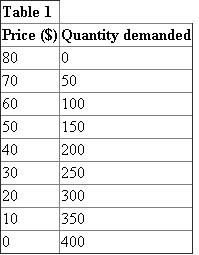 Price Elasticity Calculation (Price Decreases):
Price Elasticity Calculation (Price Decreases):
Price elasticity can be calculated as follows: Price elasticity is
Price elasticity is  . Since Price Elasticity demand is greater than 1 then quantity demand is elastic and when Price falls from$70 to $60, total revenue Increases from $3,500
. Since Price Elasticity demand is greater than 1 then quantity demand is elastic and when Price falls from$70 to $60, total revenue Increases from $3,500  to $6,000
to $6,000  .
.
Therefore, the correct answer "elastic" and "increase".
Table -1 shows the demand schedule.
 Price Elasticity Calculation (Price Decreases):
Price Elasticity Calculation (Price Decreases): Price elasticity can be calculated as follows:
 Price elasticity is
Price elasticity is  . Since Price Elasticity demand is greater than 1 then quantity demand is elastic and when Price falls from$70 to $60, total revenue Increases from $3,500
. Since Price Elasticity demand is greater than 1 then quantity demand is elastic and when Price falls from$70 to $60, total revenue Increases from $3,500  to $6,000
to $6,000  .
.Therefore, the correct answer "elastic" and "increase".
4
In each of the following instances, determine whether quantity supplied will increase or decrease, and by how much.
a. If price elasticity of supply is 1.3 and price increases by 2 percent, quantity supplied will by ______ percent.
b. If price elasticity of supply is 0.3 and price decreases by 2 percent, quantity supplied will by ______ percent.
a. If price elasticity of supply is 1.3 and price increases by 2 percent, quantity supplied will by ______ percent.
b. If price elasticity of supply is 0.3 and price decreases by 2 percent, quantity supplied will by ______ percent.

Unlock Deck
Unlock for access to all 35 flashcards in this deck.
Unlock Deck
k this deck
5
Certain skilled labor, such as hair cutting, requires licensing or certification, which is costly and takes a long time to acquire. Explain what would happen to the price elasticity of supply for haircuts if this licensing requirement were removed.

Unlock Deck
Unlock for access to all 35 flashcards in this deck.
Unlock Deck
k this deck
6
Suppose that the price of peanut butter rises from $2 to $3 per jar.
a. The quantity of jelly purchased falls from 20 million jars to 15 million jars. What is the cross-price elasticity of demand between peanut butter and jelly? Are they complements or substitutes?
b. The quantity of jelly purchased rises from 15 million jars to 20 million jars. What is the cross-price elasticity of demand between peanut butter and jelly? Are they complements or substitutes?
a. The quantity of jelly purchased falls from 20 million jars to 15 million jars. What is the cross-price elasticity of demand between peanut butter and jelly? Are they complements or substitutes?
b. The quantity of jelly purchased rises from 15 million jars to 20 million jars. What is the cross-price elasticity of demand between peanut butter and jelly? Are they complements or substitutes?

Unlock Deck
Unlock for access to all 35 flashcards in this deck.
Unlock Deck
k this deck
7
When the price of a bar of chocolate is $1, demand is 100,000 bars. When the price rises to $1.50, demand falls to 60,000 bars. Calculate the price elasticity of demand according to the instructions below and express your answer in absolute value.
a. Suppose price increases from $1 to $1.50. Calculate the price elasticity of demand in terms of percent change, as described on pages 79-80.
b. Suppose price decreases from $1.50 to $1. Calculate the price elasticity of demand in terms of percent change, as described on pages 79-80.
c. Suppose the price increases from $1 to $1.50. Calculate the price elasticity of demand using the mid-point method.
d. Suppose the price decreases from $1.50 to $1. Calculate the price elasticity of demand using the mid-point formula.
a. Suppose price increases from $1 to $1.50. Calculate the price elasticity of demand in terms of percent change, as described on pages 79-80.
b. Suppose price decreases from $1.50 to $1. Calculate the price elasticity of demand in terms of percent change, as described on pages 79-80.
c. Suppose the price increases from $1 to $1.50. Calculate the price elasticity of demand using the mid-point method.
d. Suppose the price decreases from $1.50 to $1. Calculate the price elasticity of demand using the mid-point formula.

Unlock Deck
Unlock for access to all 35 flashcards in this deck.
Unlock Deck
k this deck
8
Problems 9-12 refer to Figure 4P-2.
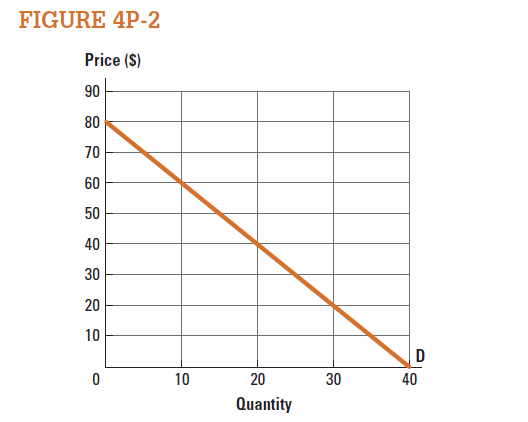
Draw the price effect and the quantity effect for a price change from $60 to $50. Which effect is larger? Does total revenue increase or decrease? No calculation is necessary.

Draw the price effect and the quantity effect for a price change from $60 to $50. Which effect is larger? Does total revenue increase or decrease? No calculation is necessary.

Unlock Deck
Unlock for access to all 35 flashcards in this deck.
Unlock Deck
k this deck
9
For each of the following pairs, predict whether the cross-price elasticity of demand will be positive or negative:
a. Soap and hand sanitizer.
b. CDs and MP3s.
c. Sheets and pillowcases.
a. Soap and hand sanitizer.
b. CDs and MP3s.
c. Sheets and pillowcases.

Unlock Deck
Unlock for access to all 35 flashcards in this deck.
Unlock Deck
k this deck
10
You are advising a coffee shop manager who wants to estimate how much sales will change if the price of a latte rises. Explain why he should measure elasticity in percentage terms rather than in terms of dollars and cups.

Unlock Deck
Unlock for access to all 35 flashcards in this deck.
Unlock Deck
k this deck
11
Although we could describe both the cross-price elasticity of demand between paper coffee cups and plastic coffee lids and the cross-price elasticity of demand between sugar and artificial sweeteners as highly elastic, the first cross-price elasticity is negative and the second is positive. What is the reason for this?

Unlock Deck
Unlock for access to all 35 flashcards in this deck.
Unlock Deck
k this deck
12
Suppose that when the average family income rises from $30,000 per year to $40,000 per year, the average family's purchases of toilet paper rise from 100 rolls to 105 rolls per year.
a. Calculate the income-elasticity of demand for toilet paper.
b. Is toilet paper a normal or an inferior good?
c. Is the demand for toilet paper income-elastic or income-inelastic?
a. Calculate the income-elasticity of demand for toilet paper.
b. Is toilet paper a normal or an inferior good?
c. Is the demand for toilet paper income-elastic or income-inelastic?

Unlock Deck
Unlock for access to all 35 flashcards in this deck.
Unlock Deck
k this deck
13
If the price elasticity of demand for used cars priced between $3,000 and $5,000 is - 1.2 (using the mid-point method), what will be the percent change in quantity demanded when the price of a used car falls from $5,000 to $3,000?

Unlock Deck
Unlock for access to all 35 flashcards in this deck.
Unlock Deck
k this deck
14
Problems 9-12 refer to Figure 4P-2.
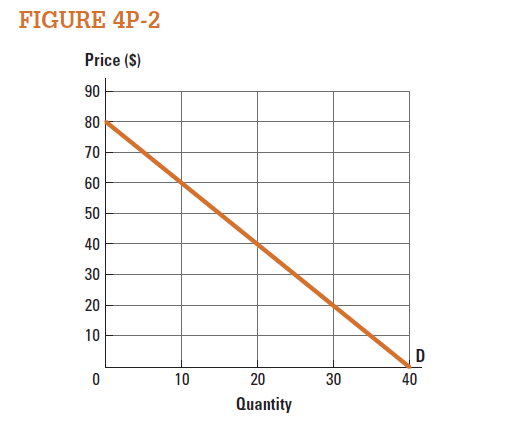
Draw the price effect and the quantity effect for a price change from $30 to $20. Which effect is larger? Does total revenue increase or decrease? No calculation is necessary.

Draw the price effect and the quantity effect for a price change from $30 to $20. Which effect is larger? Does total revenue increase or decrease? No calculation is necessary.

Unlock Deck
Unlock for access to all 35 flashcards in this deck.
Unlock Deck
k this deck
15
In each of the following instances, determine whether the good is normal or inferior, and whether it is income-elastic or income-inelastic.
a. If income increases by 10 percent and the quantity demanded of a good increases by 5 percent, the good is ______ and ______.
b. If income increases by 10 percent and the quantity demanded of a good decreases by 20 percent, the good is _______ and _____.
a. If income increases by 10 percent and the quantity demanded of a good increases by 5 percent, the good is ______ and ______.
b. If income increases by 10 percent and the quantity demanded of a good decreases by 20 percent, the good is _______ and _____.

Unlock Deck
Unlock for access to all 35 flashcards in this deck.
Unlock Deck
k this deck
16
Explain why the coffee shop manager should measure elasticity using the mid-point method in his calculations.

Unlock Deck
Unlock for access to all 35 flashcards in this deck.
Unlock Deck
k this deck
17
Name two related goods you consume which would have a positive cross-price elasticity. What happens to your consumption of the second good if the price of the first good increases?

Unlock Deck
Unlock for access to all 35 flashcards in this deck.
Unlock Deck
k this deck
18
Three points are identified on the graph in Figure 4P-1.
a. At point A, demand is ______.
b. At point B, demand is ______.
c. At point C, demand is ______.
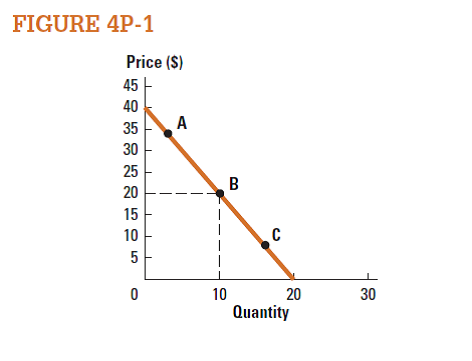
a. At point A, demand is ______.
b. At point B, demand is ______.
c. At point C, demand is ______.


Unlock Deck
Unlock for access to all 35 flashcards in this deck.
Unlock Deck
k this deck
19
Problems 9-12 refer to Figure 4P-2.
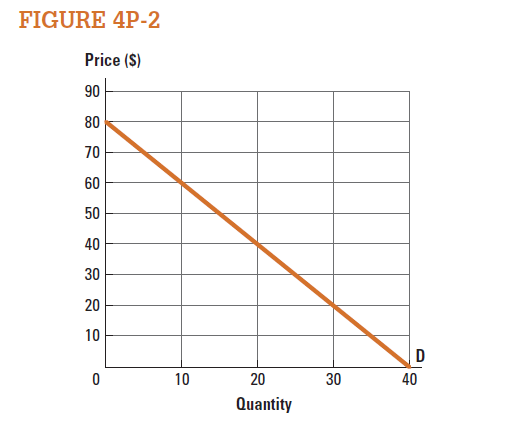
Draw the price effect and the quantity effect for a price change from $60 to $70. Which effect is larger? Does total revenue increase or decrease? No calculation is necessary.

Draw the price effect and the quantity effect for a price change from $60 to $70. Which effect is larger? Does total revenue increase or decrease? No calculation is necessary.

Unlock Deck
Unlock for access to all 35 flashcards in this deck.
Unlock Deck
k this deck
20
You are working as a private math tutor to raise money for a trip during spring break. First explain why the price elasticity of demand for math tutoring might be elastic. Then explain why the price elasticity of demand for math tutoring might be inelastic.

Unlock Deck
Unlock for access to all 35 flashcards in this deck.
Unlock Deck
k this deck
21
Name two related goods you consume which would have a negative cross-price elasticity. What happens to your consumption of the second good if the price of the first good increases?

Unlock Deck
Unlock for access to all 35 flashcards in this deck.
Unlock Deck
k this deck
22
Which of the following has a more elastic demand in the short run?
a. Pomegranate juice or drinking water?
b. Cereal or Rice Krispies ®?
c. Speedboats or gourmet chocolate?
a. Pomegranate juice or drinking water?
b. Cereal or Rice Krispies ®?
c. Speedboats or gourmet chocolate?

Unlock Deck
Unlock for access to all 35 flashcards in this deck.
Unlock Deck
k this deck
23
Problems 9-12 refer to Figure 4P-2.

Draw the price effect and the quantity effect for a price change from $10 to $20. Which effect is larger? Does total revenue increase or decrease? No calculation is necessary.

Draw the price effect and the quantity effect for a price change from $10 to $20. Which effect is larger? Does total revenue increase or decrease? No calculation is necessary.

Unlock Deck
Unlock for access to all 35 flashcards in this deck.
Unlock Deck
k this deck
24
You are working as a private math tutor to raise money for a trip during spring break. You want to raise as much money as possible. Should you should increase or decrease the price you charge? Explain.

Unlock Deck
Unlock for access to all 35 flashcards in this deck.
Unlock Deck
k this deck
25
In France, where cheese is an important and traditional part of people's meals, people eat about six times as much cheese per person as in the United States. In which country do you think the demand for cheese will be more income-elastic? Why?

Unlock Deck
Unlock for access to all 35 flashcards in this deck.
Unlock Deck
k this deck
26
In each of the following instances, determine whether demand is elastic, inelastic, or unit- elastic.
a. If price increases by 10 percent and quantity demand decreases by 15 percent, demand is ______.
b. If price decreases by 10 percent and quantity demanded increases by 5 percent, demand is ______.
a. If price increases by 10 percent and quantity demand decreases by 15 percent, demand is ______.
b. If price decreases by 10 percent and quantity demanded increases by 5 percent, demand is ______.

Unlock Deck
Unlock for access to all 35 flashcards in this deck.
Unlock Deck
k this deck
27
Use the graph in Figure 4P-3 to calculate the price elasticity of supply between points A and B using the mid-point method.
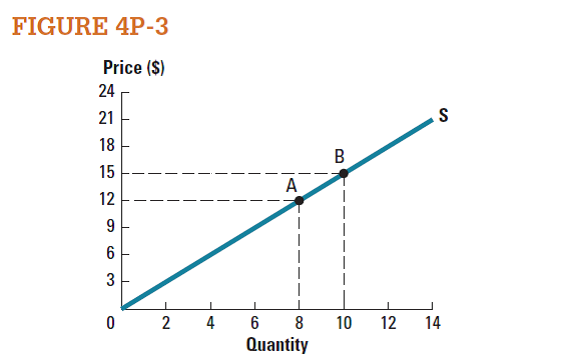


Unlock Deck
Unlock for access to all 35 flashcards in this deck.
Unlock Deck
k this deck
28
You have been hired by the government of Kenya, which produces a lot of coffee, to examine the supply of gourmet coffee beans. Suppose you discover that the price elasticity of supply is 0.85. Explain this figure to the Kenyan government.

Unlock Deck
Unlock for access to all 35 flashcards in this deck.
Unlock Deck
k this deck
29
Name a good you consume for which your income elasticity of demand is positive. What happens when your income increases?

Unlock Deck
Unlock for access to all 35 flashcards in this deck.
Unlock Deck
k this deck
30
In each of the following instances, determine whether quantity demanded will increase or decrease, and by how much.
a. If price elasticity of demand is -1.3 and price increases by 2 percent, quantity demanded will _________ by_______ percent.
b. If price elasticity of demand is -0.3 and price decreases by 2 percent, quantity demanded will ___________ by______ percent.
a. If price elasticity of demand is -1.3 and price increases by 2 percent, quantity demanded will _________ by_______ percent.
b. If price elasticity of demand is -0.3 and price decreases by 2 percent, quantity demanded will ___________ by______ percent.

Unlock Deck
Unlock for access to all 35 flashcards in this deck.
Unlock Deck
k this deck
31
If the price of a haircut is $15, the number of haircuts provided is 100. If the price rises to $30 per haircut, barbers will work much longer hours, and the supply of haircuts will increase to 300. What is the price elasticity of supply for haircuts between $15 and $30?

Unlock Deck
Unlock for access to all 35 flashcards in this deck.
Unlock Deck
k this deck
32
You have noticed that the price of tickets to your university's basketball games keeps increasing but the supply of tickets remains the same. Why might supply be unresponsive to changes in price?

Unlock Deck
Unlock for access to all 35 flashcards in this deck.
Unlock Deck
k this deck
33
Name a good you consume for which your income elasticity of demand is negative. What happens when your income increases?

Unlock Deck
Unlock for access to all 35 flashcards in this deck.
Unlock Deck
k this deck
34
Problems 7 and 8 refer to the demand schedule shown in Table 4P-1. For each price change, say whether demand is elastic, unit-elastic , or inelastic , and say whether total revenue increases, decreases , or stays the same.
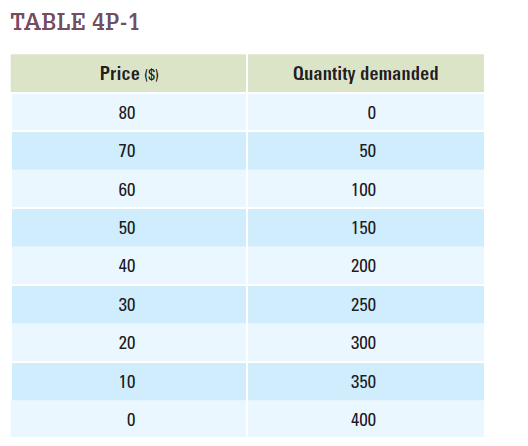
Price increases from $10 to $20. Demand is _____ and total revenue ______.

Price increases from $10 to $20. Demand is _____ and total revenue ______.

Unlock Deck
Unlock for access to all 35 flashcards in this deck.
Unlock Deck
k this deck
35
Which of the following has a more elastic supply in the short run?
a Hospitals or mobile clinics?
b. Purebred dogs or pet rabbits?
c. On-campus courses or online courses?
a Hospitals or mobile clinics?
b. Purebred dogs or pet rabbits?
c. On-campus courses or online courses?

Unlock Deck
Unlock for access to all 35 flashcards in this deck.
Unlock Deck
k this deck



